Types of Desert Cacti (With Pictures) – Identification Guide
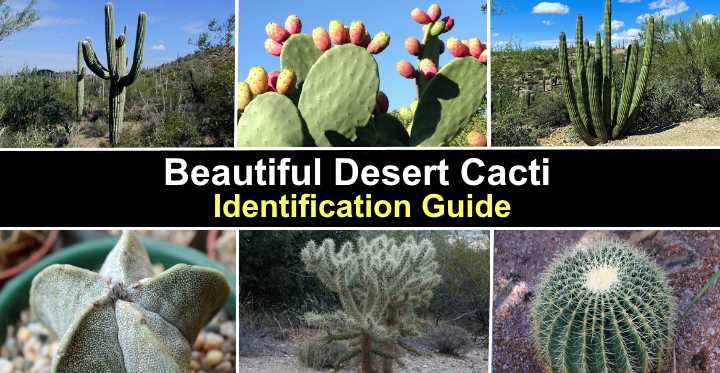
Desert cacti are the most easily recognizable features of dry arid landscapes, especially in Arizona, Utah, Nevada, and California. Succulent plants that thrive in the desert must withstand periods of drought, hot sun, and nutrient-deficient soil. In addition, desert cacti that thrive in the southwestern United States must endure freezing temperatures during the night.
Desert cacti are relatively easy to identify in barren landscapes and arid deserts. Typically, the desert plants are columnar, green, and covered in sharp or soft spines. However, some common cacti growing in the desert are barrel-shaped or have flat, plate-like leaves and prickly pear fruits. In addition, many cacti have colorful, showy flowers that bloom at various times of the year.
This article is a guide for identifying a wide variety of desert cacti. Descriptions and pictures of succulent desert plants will help distinguish between various species.
How to Identify Desert Cacti
To identify a variety of cacti, look at the shape of their succulent stems and whether there are sharp spines. Then take note of the cactus shape, size, and type of flowers. For example, some varieties of cacti have a ridged-like appearance or ribs on their cylindrical stems. In contrast, others are covered in small bumps or spiked areoles.
Cacti are a type of succulent plant belonging to the family Cactaceae. There are over 190 species of cacti native to the United States. These are divided into several genera based on their characteristics, appearance, and habitat.
Types of Desert Cacti (With Pictures) – Identification Guide
Let’s look in detail at several species of desert cacti, starting with the most iconic desert plant — the giant saguaro cactus.
Saguaro Cactus (Carnegiea gigantea)
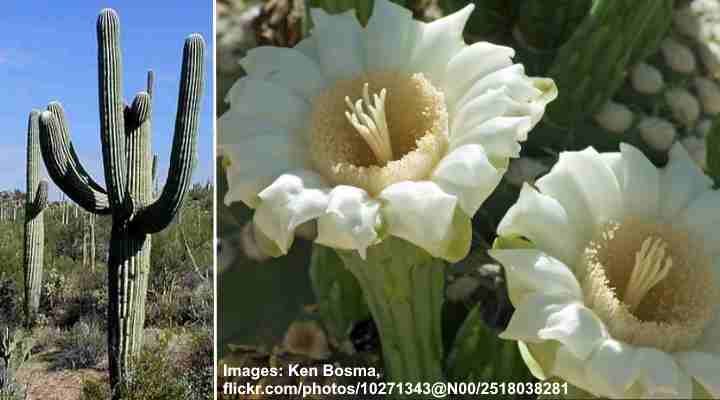
The huge saguaro cactus has large white flowers and is common in Arizona Sonoran desert
The saguaro cactus is one of the largest cacti in Arizona. The identifying features of this desert cactus are its arm-like branches curved upward and attached to a thick columnar stem. The green, cylindrical stems have a ribbed appearance and are covered in spiny stems called arms.
The saguaro cactus is an enormous, slow-growing desert plant that grows up to 52 ft. (16 m) tall. The huge cactus blooms with white, trumpet-like cactus flowers, each measuring 5” (13 cm) long. These attract hummingbirds and bees in late spring and summer when in bloom. These are followed by red edible fruits that ripen in June.
The native range of the saguaro cactus is southern Arizona in the Sonoran desert. It thrives in flat, rocky areas or on slopes. Their growth rate and mature height depend on rainfall; therefore, saguaro cacti in western Arizona tend to be smaller than those in southern Arizona.
Organ Pipe Cactus (Stenocereus thurberi)
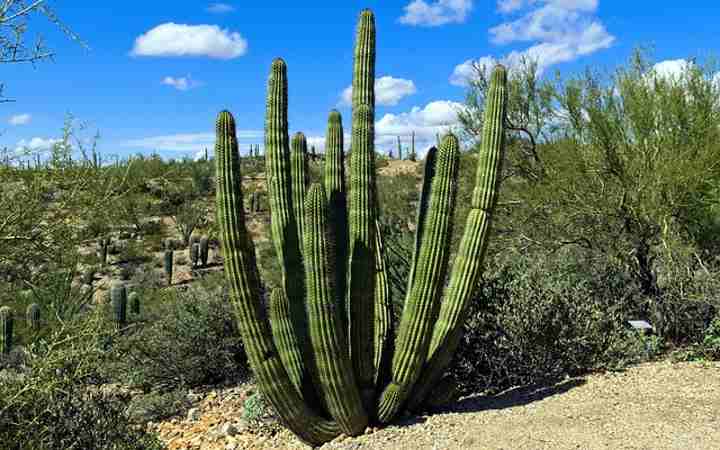
The organ pipe is a tall slow growing cactus with cylindrical vertical stems that grows well in desert soil
The organ pipe cactus is a type of columnar cactus with cylindrical stems. The ribbed, green stems grow up to 16 ft. (5 m) tall and have prominent ridges running vertically. This clumping desert cactus is characterized by vertical stems that look like a pipe organ — hence its common name.
Attractive features of the multi-stemmed desert cactus are its columnar shape, white flowers that open in the evening, and large fruit about the size of a tennis ball.
The native range of the organ pipe cactus is mostly in the Sonoran Desert, southern Arizona, and Sinaloa and Baja California. The slow-growing cactus thrives in desert landscapes and withstands drought and rocky, infertile soils.
Prickly Pear Cactus (Opuntia)
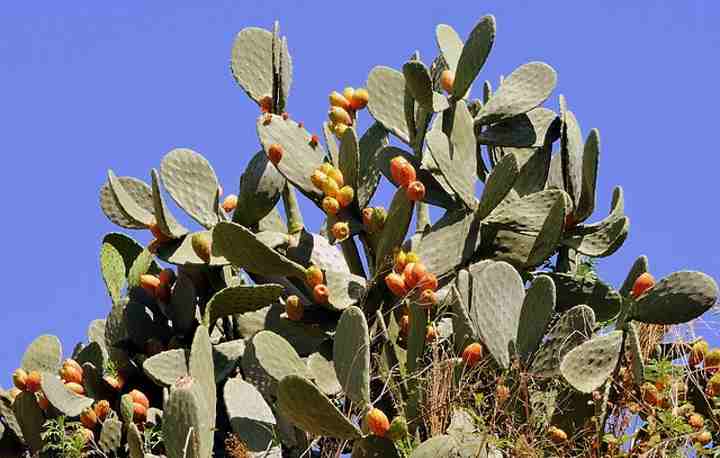
The prickly pear cactus is a common sight in desert landscapes with its padded leaves and orange fruits
The prickly pear is a common cactus found in dry, arid desert environments. This iconic desert cactus has paddle-shaped, pad-like leaves covered in barbed spines. Some features of this cactus genus are its showy red, yellow or purple flowers and the egg-shaped orange fruits growing from the leaf tips.
The most common prickly pear species in Arizona is the Indian fig opuntia (Opuntia ficus-indica). This genus of cacti can grow 16 to 23 ft. (5 – 7m) tall and is characterized by several large pads in a disc shape forming a large thicket.
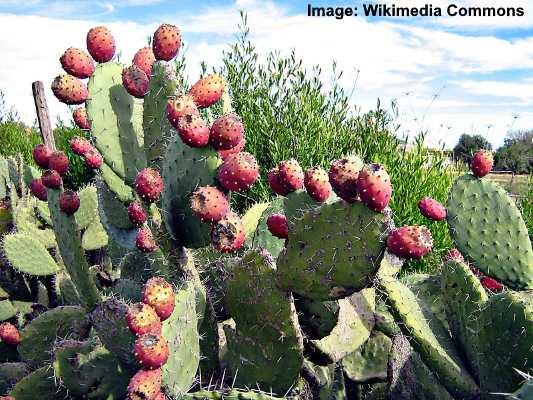
The Indian fig opuntia has fruits ranging in color from green to dark red
The range of the prickly pear cactus is throughout the southern United States — from Florida through Texas and Arizona to California. Although it typically thrives in a dry habitat, the prickly pear also performs well in cultivation.
Violet Prickly Pear (Opuntia gosseliniana)
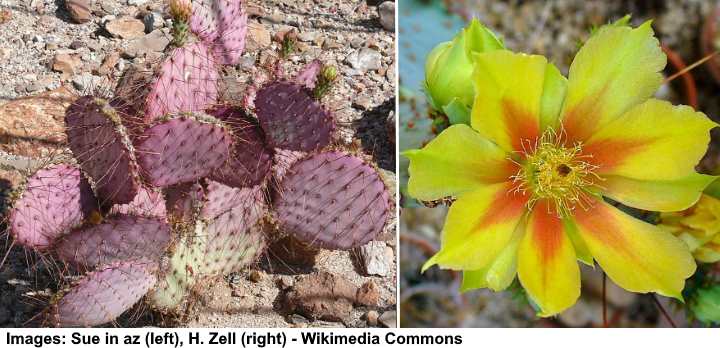
The violet prickly pear is a common Arizona cactus with purple pads and yellow flowers
The violet prickly pear is commonly seen in the dry Arizona landscape. This purple-colored desert cactus is identified by its numerous flat stems or pads that are a waxy blueish-gray color with deep purple coloring on the stem edges. These disc-shaped flat pads are covered in sharp, stiff spines. Cactus flowers are generally yellow.
The violet prickly pear grows large circular stems on the main trunk. The unusual desert plant grows 1 to 5 ft. (0.3 – 1.5 m) tall and up to 6 ft. (1.8 m) wide. This plant also grows well in sunny landscapes and is suitable for planting in a xeriscape garden or cactus garden.
The violet prickly pear is a cactus native to Baja California, Arizona, and the Sonoran Desert. The large cactus thrives just as well in a typical desert biome as it does in grasslands.
Bunny Ears Cactus (Opuntia microdasys)
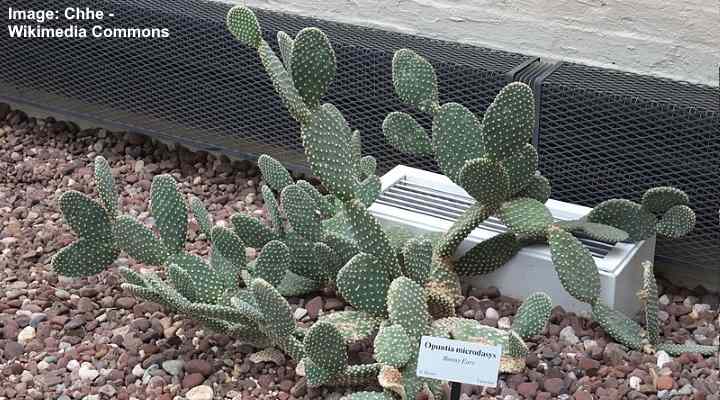
The bunny ears cactus is identified by its flat green pads and is easily grown in arid desert landscapes
Also called rabbit ears, the bunny ears cactus is a native desert plant in the Chihuahuan Desert. Like all Opuntia cactus plants, this green cactus is identified by its flattened, oval stems or pads. The multiple cactus stems form a shrub-like plant in the desert environment. The green pads are covered in fine barbed spines.
The characteristic features of the bunny ears cactus are its numerous pad-like stems, whitish bumps, yellow flowers, and long fruits growing 2” (5 cm) long. The shrub-like cactus plant grows 3 to 4 ft. (1 – 1.2 m) tall and up to 5 ft. (1.5 m) wide.
The bunny ears cactus is commonly found in American deserts in the southwest — Arizona, California, Nevada, and New Mexico. This easy-to-grow cactus thrives in arid landscapes.
Bunny ears cactus is a popular potted succulent to grow indoors. Find out more about how to care for cactus houseplants.
Golden Barrel Cactus (Echinocactus grusonii)

The round shape of the golden barrel cactus looks attractive in xeriscape garden
The stout, round shape of the golden barrel cactus makes it easy to identify this large desert plant in Arizona landscapes. The golden barrel plant has large yellowish spikes covering the ball-shaped cactus. The cactus blooms with a ring of yellow flowers, forming an attractive crown.
The slow-growing golden yellow and green globular cactus grows up to 3 ft. (1 m) tall and 2 ft. (0.6 m) wide. This type of barrel cactus is a popular addition to rock gardens, desert gardens, or for growing in containers.
The native range of the golden barrel cactus is Central Mexico. However, the rounded, spiked cactus thrives in the American southwest in dry arid landscapes and sandy or gravel soil.
Hedge Cactus (Cereus hildmannianus)
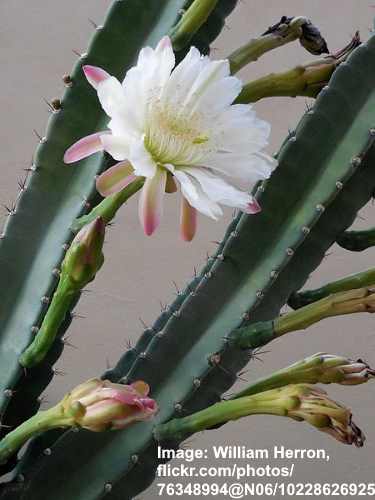
The tall hedge cactus has cylindrical ribbed stems and beautiful white flowers
The hedge cactus is a type of cactus tree with a distinct trunk and succulent branches or stems. The bluish-green stems are cylindrical, with four to six ribs running the length. The stem edges have small areoles and soft reddish spines. This flowering cactus has showy white flowers and ornamental fruits.
Also called the Peruvian apple cactus, this tree-like desert plant grows up to 50 ft. (15 m) tall. However, it’s usually shorter when growing in residential landscapes. In southwestern gardens, the columnar stems grow as a large bush rather than a cactus tree.
The hedge cactus grows well throughout Nevada, southern California, Arizona, and Texas. In addition, the ornamental cactus is widely cultivated and used for living fences or specimen plants.
Old Man Cactus (Pachycereus schottii)
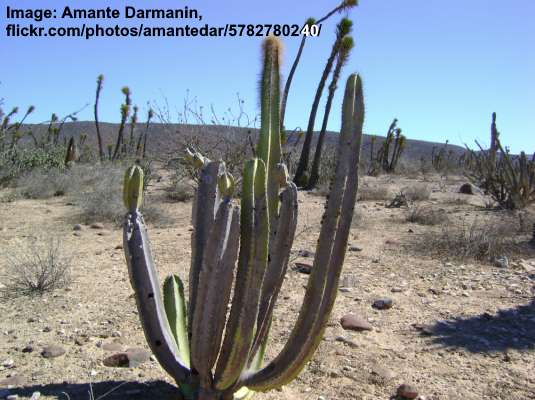
The old man cactus has a columnar growth habit and thrives in sunny arid desert environment
The old man cactus is a large columnar cactus plant that forms a large shrub. The upward-growing bluish-green cactus stems have prominently ribbed edges with short black or brown spines. Another feature of this attractive cactus is its large white flowers that appear in summer, followed by bright red egg-shaped fruits.
The old man cactus grows 10 ft. (3 m) tall and wide. Because of its habit of flowering on summer nights, it has the common name queen of the night.
Also called the senita cactus, this native cactus thrives in Southern Arizona, the Sonoran Desert, northern Mexico, and Baja California. The best habitat for the plant is full sun, parched, well-drained ground, and plenty of sunshine.
Spinystar Cactus (Escobaria vivipara)
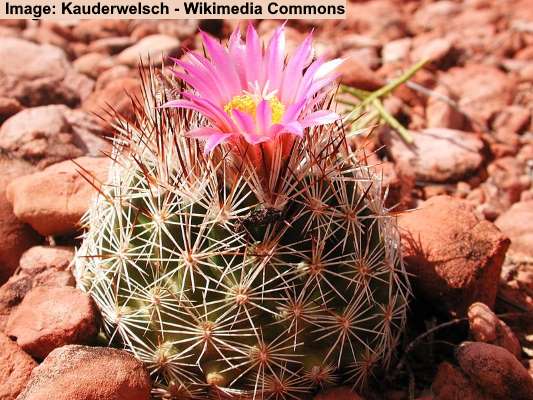
The small rounded spinystar cactus has numerous white spines and colorful flowers and can form clusters of cacti in various sizes
The spinystar desert plant is a small, spiky cactus with a distinctive ball shape. Identifying features of this rounded cactus are its straight white spines measuring 1” (2.5 cm) long and cactus flowers in pink, red, purple, or yellow colors. The ball-like cacti grow, forming large clusters of various-sized plants of up to 24 round stems.
Also called the beehive cactus, ball cactus, or pincushion cactus, this small round succulent plant grows up to 6” (15 cm) tall and wide with a spherical shape.
The spinystar cactus native range is the Sonoran and Mojave Deserts. Despite its small size, the cluster of these ball-shaped cacti can be relatively large. This common native cactus thrives throughout North America in sandy or rocky soil.
Teddy Bear Cholla (Cylindropuntia bigelovii)
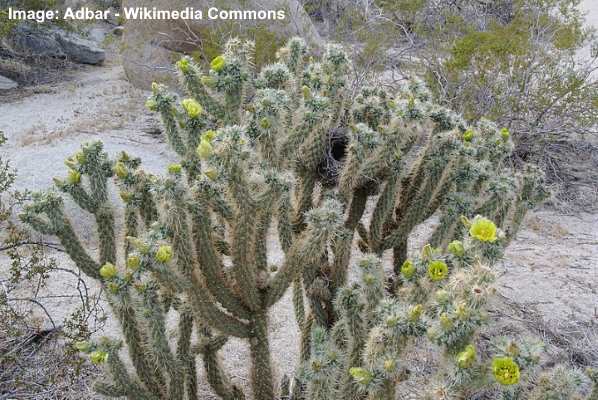
The teddy bear cholla is a tree-like cactus with sharp spines and yellowish flowers
The teddy bear cholla is a small, clumping, low-growing cactus plant that thrives in coastal desert landscapes. Despite the fuzzy appearance of the cactus, it’s covered in sharp, silvery-white dense spines. Other identifying features of the cholla cactus are its yellow-green flowers, tree-like appearance, and gray-green stems.
The teddy bear cholla grows 1 to 5 ft. (0.3 – 1.5 m) tall. The small cactus looks like a small tree with distinct branching and new stems growing from stem tips. Due to its exceedingly sharp spines, the cactus is ideal as a foundation planting or security plant in arid landscapes.
The native range of the teddy bear cholla is Sonoran and Colorado Deserts and northwestern Mexico. However, it also grows in other regions of the southwestern US. It is also found in the Joshua Tree National Park.
Cane Cholla (Cylindropuntia spinosior)

The cane cholla is a popular desert cactus with cylindrical stems, purple flowers and yellow fruit when mature
The cane cholla is a native cactus plant in Arizona and New Mexico. The attractive desert cactus is identified by its tree-like branching with cylindrical spiky stems. The stem segments can measure 2” to 20” (5 – 50 cm) long. Ornamental features of the cactus are its bright purple flowers and yellowish-green fruit.
The cane cholla is a low-growing branching cactus plant that grows 1.3 to 4 ft. (0.4 – 1.2 m) tall. The small tree-like cactus is a popular landscape plant in dry areas because of its drought tolerance and direct sunlight.
The cane cholla is native to the Sonoran and Chihuahuan Deserts and thrives throughout Arizona landscapes. It thrives in habitats that include desert valleys, grasslands, and high elevations.
Golden-Spined Cereus (Bergerocactus emoryi)
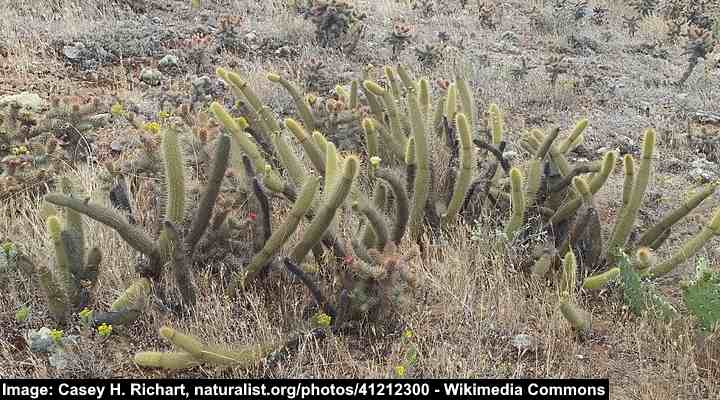
The golden-spined cereus is a thicket-forming cactus with attractive yellow flowers
The golden-spined cereus is a small cactus plant that grows as spiny thickets on the desert floor. It’s a shrub-like cactus with columnar or prostrate stems covered in golden yellow sharp spines. Additional identifying features are its large yellow flowers and reddish globular fruits.
Also called the golden snake cactus, golden cub cactus, and velvet cactus, the dwarf cactus has mostly upward-growing thick, spine-covered stems. The upward-growing stems reach 3 ft. (1 m) tall when growing as a thicket. However, when growing low to the ground, its spiky yellow stems can grow up to 6.6. ft. (2 m) long.
Golden-spined cereus is a cactus shrub native to California, Arizona, and New Mexico. The thicket-forming cactus thrives in sandy, coastal regions, and grassy or partly wooded slopes.
Bishop’s Hat Cactus (Astrophytum myriostigma)
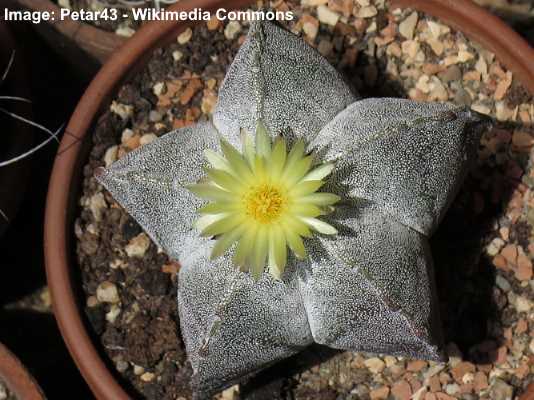
The bishop’s hat cactus can be easily identified by its unique star shape
The bishop’s hat is an easily identifiable desert cactus plant due to its rounded shape with three to seven pronounced vertical ribs. From above, the desert plant has a distinctive star shape. The native low-growing bluish-green cactus has a prominent yellow flower when it blooms. This is followed by reddish fruit, giving the cactus enormous decorative appeal.
Also called the bishop’s miter cactus, this unusual succulent plant grows 2.4 to 3.3 ft. (0.7 – 1 m) tall. As the cactus grows, it becomes more cylindrical rather than dome-shaped. A unique feature of the cactus is that it lacks discernable spines and whitish tufts common to many cacti.
The native range of the bishop’s hat cactus is central to northern Mexico and southern California. The cactus plant thrives in dry climates, stony soils, and scrubby plains, where it gets plenty of direct sunlight and no shade.
Mexican Fencepost Cactus (Lophocereus marginatus)
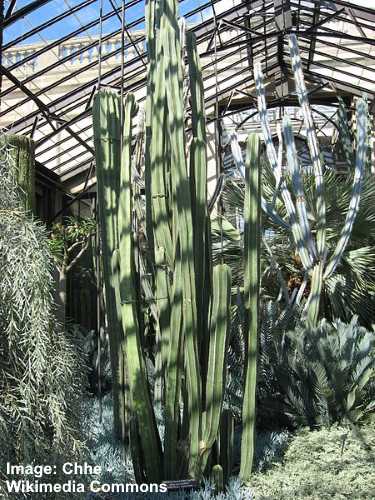
The tall columnar Mexican fencepost cactus has ribbed cylindrical stems and is a focal point in desert landscapes
The Mexican fencepost cactus is a tall, columnar desert cactus plant with deep green, erect stems covered in short spines. The clump-forming cactus is relatively easy to grow. It has ribbed stems up to 4” (10 cm) in diameter, pinkish flowers, and spiny yellow or red fruits.
This elegant, upright cactus with its straight stems can grow up to 15 ft. (4.5 m) tall and 4 ft. (1.2 m) wide. Several stems can grow together, creating an attractive landscaping feature in arid conditions. You can plant the cactus as a windbreak, specimen plant, or evergreen hedge.
The Mexican fencepost cactus is native to Central Mexico. However, it thrives in the southwestern United States in residential landscapes. The desert cactus plant grows easily in fertile, well-drained soils and direct sunlight.
Arizona Pencil Cholla (Cylindropuntia arbuscula)
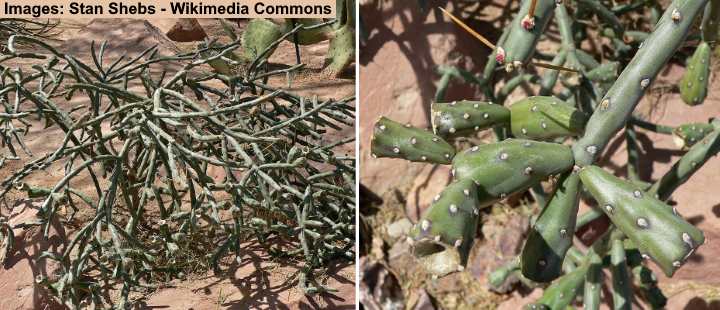
The multi branched Arizona pencil cholla is relatively low growing desert cactus with yellow flowers and sharp spines
The Arizona pencil cholla is a multi-branching desert plant with thin stems, long, sharp brown spikes, and shrub-like growth. The identifiable features of the cactus are its yellowish-green flowers with yellow centers, needle-like spines, and relatively low height. The easy-to-grow landscaping cactus plant is popular for arid climates.
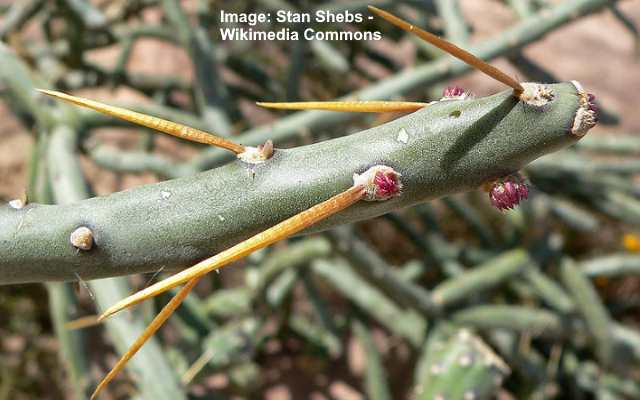
A close up picture of Arizona pencil cholla thorns
The Arizona pencil cholla grows 3 to 4 ft. (1 – 1.2 m) tall and wide. Its growth consists of sparsely to densely growing thin stems no more than 0.5” (1.5 cm) thick. Additionally, its bright yellow blooms appear in late spring and early summer and measure 1.2” (3 cm) in diameter.
This native Arizona desert plant thrives in the southern part of the state in the Sonoran Desert and into northern Mexico. This drought-tolerant plant doesn’t require any extra care once established and will flourish in a parched desert landscape.
Related articles:
